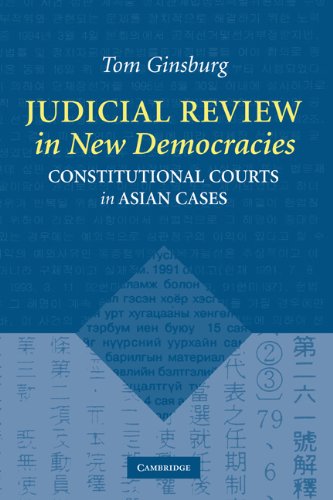Tom Ginsburg0521817153, 9780521817158, 9780511061134
Table of contents :
Cover……Page 1
Half-title……Page 3
Title……Page 5
Copyright……Page 6
Dedication……Page 7
Contents……Page 9
Acknowledgments……Page 11
Notes on Usage……Page 13
THE DECLINE OF PARLIAMENTARY SOVEREIGNTY……Page 17
CONSTITUTIONALISM IN EAST ASIA……Page 27
AMERICAN EXCEPTIONALISM?……Page 31
APPROACH AND PLAN OF THE BOOK……Page 33
1 Why Judicial Review?……Page 37
JUDICIAL REVIEW AS INSURANCE……Page 38
INSURANCE IN NEW DEMOCRACIES……Page 46
CONCLUSION……Page 49
2 Constituting Judicial Power……Page 50
TAILORING THE INSURANCE CONTRACT: DIMENSIONS OF INSTITUTIONAL DESIGN……Page 51
Access……Page 52
Effect……Page 56
Mechanisms of Appointment and Accountability……Page 58
Term Length……Page 62
Court Size……Page 63
Summary……Page 64
Judicial Review as Insurance: Anecdotal Evidence……Page 65
The Design of Judicial Review: Empirical Evidence……Page 76
3 Building Judicial Power……Page 81
COURTS AS STRATEGIC ACTORS……Page 82
CONSTRAINTS ON THE COURT……Page 93
Comply?……Page 94
Overrule?……Page 95
Counterattack?……Page 96
Policy Space……Page 97
REGIME TYPE AND STRATEGIC CONSTRAINT……Page 98
THE STRATEGY OF CASE SELECTION……Page 102
4 Courts in New Democracies……Page 106
THE U.S. SUPREME COURT AND THE ESTABLISHMENT OF JUDICIAL REVIEW……Page 107
THE SECOND WAVE OF JUDICIAL REVIEW: POSTFASCISM AND POSTCOLONIALISM……Page 112
Hungary: Compliance……Page 115
Russia: Counterattack……Page 117
CONCLUSION: CAUTIOUS COURTS……Page 120
INTRODUCTION……Page 122
THE DEVELOPMENT OF CONSTITUTIONAL THOUGHT IN CHINA……Page 125
THE CONSTITUTION OF 1947……Page 127
Five-Power Scheme and Executive Dominance……Page 128
Temporary Provisions……Page 129
Centralized Judicial Review: The Dynamics of Design……Page 131
THE AUTHORITARIAN REGIME, CONSTITUTIONAL CHANGE, AND DEMOCRATIZATION……Page 133
Formation……Page 136
Functions and Operations……Page 139
Introduction……Page 140
Instrument……Page 144
Discipline and Punishment……Page 146
Building Jurisdiction I: Ordinary Court–Council Relations……Page 150
Building Jurisdiction II: The Uses of Administrative Law……Page 156
Building Jurisdiction III: Avoiding the Council Law Restrictions……Page 158
Enforcement: Deadlines for Compliance……Page 159
THE COUNCIL AND DEMOCRATIZATION……Page 160
Interpretation No. 261 and the Return of Taiwan……Page 161
Reclaiming Political Space a Step at a Time……Page 164
Political Questions: Challenging the Emperor?……Page 167
Leading or Following? The Council and Political Reform……Page 170
CONCLUSION: THE JUDICIALIZATION OF POLITICS UNDER GRADUAL CONSTITUTIONAL REFORM……Page 173
INTRODUCTION……Page 174
Legal Tradition and Political History……Page 176
Democratic Transition: 1989–1992……Page 178
Setting the Institutional Framework: The 1992 Constitution……Page 180
The Constitutional Tsets……Page 181
Membership of the Court……Page 189
First Cases: Testing Grounds……Page 191
Citizen Petitions and Rights Jurisprudence……Page 193
The Court and the Supreme Court……Page 195
THE COURT AND THE SEPARATION OF POWERS……Page 198
Interbranch Disputes……Page 199
Judicial Independence……Page 200
The Character of the Political System and the Separation of Powers……Page 203
Political Impact of the Separation Decision……Page 208
Response and Restructuring……Page 212
THEORY AND THE MONGOLIAN CASE……Page 216
CONCLUSIONS……Page 220
INTRODUCTION……Page 222
THE KOREAN LEGAL TRADITION AND THE AUTHORITARIAN PERIOD……Page 224
THE 1987 CONSTITUTIONAL AMENDMENTS AND DEMOCRATIZATION……Page 229
THE CONSTITUTIONAL COURT: STRUCTURE AND OPERATIONS……Page 234
PERFORMANCE OF THE COURT: QUANTITATIVE DATA……Page 237
New and Unenumerated Rights……Page 242
The Court and the Political Process……Page 243
The Court and Kwangju: Issues of Retroactive Justice……Page 244
Economic Rights……Page 248
Social Issues……Page 249
Labor Issues……Page 250
The National Security Act Cases and Military Secrets……Page 252
Political Questions?……Page 254
RELATIONS WITH THE SUPREME COURT……Page 255
CONCLUSION……Page 258
THE DESIGN OF SYSTEM: JUDICIAL REVIEW AS INSURANCE……Page 263
THE PERFORMANCE OF THE SYSTEM……Page 267
INTERCOURT CONFLICT……Page 271
EXPLAINING VARIATION: ALTERNATIVE HYPOTHESES……Page 272
CONCLUSION……Page 277
Bibliography……Page 281
Index……Page 297

Reviews
There are no reviews yet.